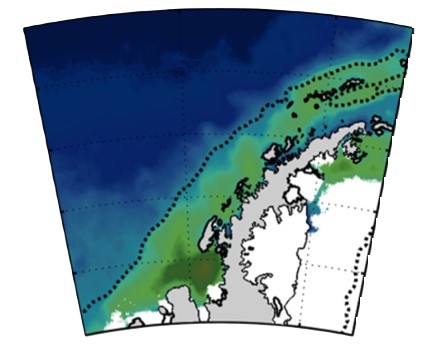High latitude polar ecosystems are often treated as a single entity in global studies of phytoplankton phenology characterized by short-duration, high-intensity summer phytoplankton blooms. Indeed, the IPCC (2019) summarizes with “high confidence” that changes in polar sea ice and ocean stratificationare occurring, causing changes in the “timing, duration, and intensity of primary production.” In a warming climate, start dates of the phytoplankton growing season at high latitudes are predicted to shift earlier by about five days per decade. However, polar seas with seasonal sea ice experience more variability than the broad high-latitude regions examined in global phenology modeling studies. Our NASA Interdisciplinary Science project recently used a 25-year record from satellite ocean color data to document how the Southern Ocean is not a single ecosystem and how phytoplankton dynamics in the spring and fall are changing.
Estimates of Southern Ocean air-sea CO2 fluxes remain highly uncertain both in terms of long-term trends and the contemporary magnitude to the point that there is ongoing debate on the sign of basin-wide flux. We leverage recent and ongoing projects to evaluate linkages between environmental forcing and optical, biological and biogeochemical observations from open ocean to nearshore ecosystems. In particular, observations made with the ongoing Palmer Long-Term Ecological Research (PAL-LTER), SOCCOM Bio-Argo profiling floats and the Drake Passage Time series (DPT) projects provide ongoing long-term datasets and tuned biogeochemical models along the coastal region of the West Antarctic Peninsula (WAP) and in the Drake Passage. This project stems from a NASA Interdisciplinary Research Project exploring the uptake of CO2 in a rapidly changing oceanic region near the West Antarctic Peninsula by examining the relationship of pCO2sur to sea ice phenology, mixed layer depth, phytoplankton blooms and their species composition. A primary aim here is to use detailed field observations and models to advance understanding of the physical and biological controls on air-sea exchange of CO2 across zones in the Southern Ocean and explore new approaches to monitor.
See new publication from Turner et al. (accepted).
Collaborators: Heidi Dierssen (UConn), Jessica S. Turner (UConn), Oscar Schofield (Rutgers) , Heather H. Kim (WHOI), Sharon Stammerjohn (Univ. Colorado), David R. Munro (Univ. Colorad0), Maria Kavanaugh (Oregon State), Afonso Ferreira, Jack Pan, Hilde Oliver (WHOI), Henry Housekeeper (WHOI)
Funding: NASA Ocean Biology and Biogeochemistry
Publications
Brown, M. S., Bowman, J. S., Lin, Y., Cassar, N., Schofield, O. 2021. Low diversity of a key phytoplankton group along the West Antarctic Peninsula. Limnology and Oceanography. DOI: 10.1002/lno.11765 Related to phytoplankton community diversity.
Cetinic, I, C.S. Rousseaux, et al. 2024. Phytoplankton composition from sPACE: requirements, opportunities, and challenges. Remote Sensing of Environment 302 (2024) 113964. https://doi.org/10.1016/j.rse.2023.113964
Dierssen, H. M., Ackleson, S. G., Joyce, K., Hestir, E., Castagna, A., Lavender, S. J., et al. 2021. Living up to the Hype of Hyperspectral Aquatic Remote Sensing: Science, Resources and Outlook. Frontiers in Environmental Science 9, 134. Related to phytoplankton biodiversity algorithms.
Dierssen, H.M., M. Gierach, L.S. Guild, A. Mannino, J. Salisbury, S. Schollaert Uz, J. Scott, P.A. Townsend, K. Turpie, M. Tzortziou, E. Urquhart, R. Vandermeulen, and P.J. Werdell. 2023. Synergies between NASA’s Hyperspectral Aquatic Missions PACE, GLIMR, and SBG: Opportunities for new science and applications. Journal of Geophysical Research. 128(10): e2023JG007574. DOI: 10.1029/2023JG007574
Khan, A. L., H. Dierssen, T. Scambos, J. Höfer, and R. R. Cordero. 2021. Spectral Characterization, Radiative Forcing, and Pigment Content of Coastal Antarctic Snow Algae: Approaches to Spectrally Discriminate Red and Green Communities and Their Impact on Snowmelt. The Cryosphere. 15, 133-148. Related to analysis of hyperspectral reflectance measurements in Antarctic ecosystems.
Kim, H. H., Luo, Y., Ducklow, H. W., Schofield, O., Steinberg, D. K., Doney, S. C. 2021. WAP-1D-VAR v1.0: Development and Evaluation of a One-Dimensional Variational Data Assimilation Model for the Marine Ecosystem Along the West Antarctic Peninsula. Geoscientific Model Development. https://doi.org/10.5194/gmd-2020-375. Related to modeling the microbial dynamics.
Nardelli, SC, Gray, PC, Stammerjohn, SE, and Schofield, O. (2023). Characterizing coastal phytoplankton seasonal succession patterns on the West Antarctic Peninsula. Limnology and Oceanography, 68, 845-861. https://doi.org/10.1002/lno.12314
Nardelli, S., Gray, P., Schofield, O. 2022. Developing a convolutional neural network to classify phytoplankton images collected with an Imaging FlowCytobot along the West Antarctic Peninsula. Marine Technology Society Journal 56:45-57.
Nardelli, S. 2022. Seasonal Dynamics of Plankton Ecology in Coastal Antarctica. Rutgers University. Ph.D. Thesis.
Saenz BT, McKee DC, Doney SC, Martinson DG, and Stammerjohn SE. (2023). Influence of seasonally varying sea-ice concentration and subsurface ocean heat on sea-ice thickness and sea-ice seasonality for a ‘warm-shelf’ region in Antarctica. Journal of Glaciology 1–17. https://doi.org/10.1017/jog.2023.36 (published June 2023)
Schofield, O. (Chair), Barger, A., Brunt, K., Clauer, R., Das, I., Detrich, W., Gooseff, M., Halanych, K., Halpern, M., Murray, A., Rignot, E., Shevenell, A., Takai, H., Wilson, T., Wolff, E. 2021. Mid-term Assessment of progress on the 2015 strategic vision for Antarctic and Southern ocean research. Ocean Studies Board, National Research Council. ISBN 978-0-309-26807-3 | DOI 10.17226/26338 160pp.
Schultz, C., Doney, S. C., Hauck, J., Kavanaugh, M. T., and Schofield, O. (2021). Modeling Phytoplankton Blooms and Inorganic Carbon Responses to Sea-Ice Variability in the West Antarctic Peninsula. Journal of Geophysical Research: Biogeosciences 126, e2020JG006227. Related to carbon and phytoplankton linkages.
Stukel, M. R., Ducklow, H. W., Schofield, O. 2022. Seasonal variability in carbon:234thorium ratios of suspended and sinking particles in coastal Antarctic waters: Potentially important roles for diatoms and euphausiid fecal pellets. Deep Sea Research II (10.1101/2022.01.07.475468)
Turner, J.S., Dierssen, H., Schofield, O., Kim, H.H., Stammerjohn, S., Munro, D.R., & Kavanaugh, M. Accepted. Changing phytoplankton phenology in the marginal ice zone west of the Antarctic Peninsula. Marine Ecology Progress Series.